No. 50
Prep for a neater paint job
Protect against slop, splatter and spills
It’s a great feeling: the satisfaction of a newly painted room transformed by a fresh color. But hasty prep and accidents can erase that satisfaction, leaving you with messy regrets. Here’s how to goof-proof your next painting project.
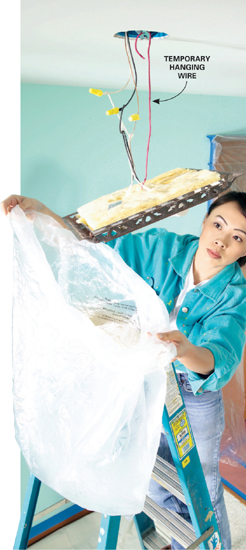
Bag light fixtures
Painting a ceiling is a cinch—except for the light fixture. Here’s how to get it out of your way: First remove any glass parts, including the bulbs (make sure the power is off). Unfasten the fixture, usually by removing a couple of screws. Then hook one end of a wire through the fixture and the other to the junction box. Make sure your hanging wire—not the electrical wire—supports the fixture. Then slip a plastic bag over the fixture.
Dealing with chandeliers and pendants is even easier. The decorative plate at the ceiling is usually held up by a ring nut. Just unscrew the nut and the plate will slide down over the chain or tube. There’s no need to support the fixture with wire.
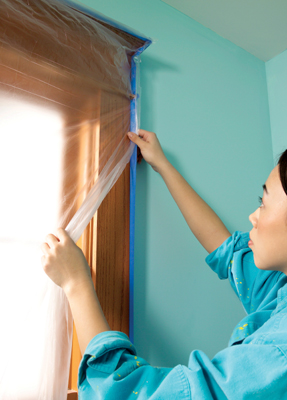
Sheet over doors and windows
Paint rollers throw off a mist of paint that speckles everything below. Here’s the quickest way to protect doors and windows: When you tape around door and window trim, use tape that’s wide enough to project at least 1/2 in. from the trim. That way, you can stick light plastic to the protruding tape—there’s no need to tape the perimeter of the plastic separately. For doors, slit the plastic with a utility knife so you can slip through.
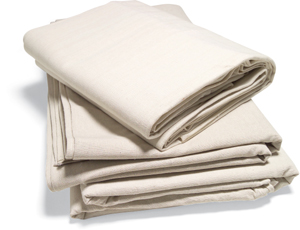
Cover carpet with canvas
Canvas dropcloths are the best coverings for carpet. They’re easy to spread out, and unlike plastic, they stay put without tape. Just bunch them up a bit along walls and they’ll stay where you want them. Good dropcloths aren’t cheap, but you don’t have to cover the entire floor. Many pro painters use a long, narrow “runner” that they drag around the room as they go. Normal drips and splatter won’t soak through canvas, but heavy spills might, so clean up major spills immediately.
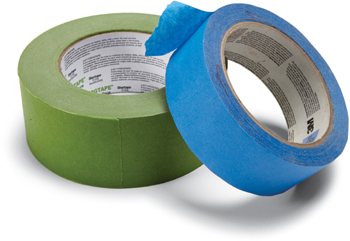
Spend more on painter’s tape
When buying masking tape, let price be your guide. More expensive tapes block paint better and release easier without harming surfaces. You might save $3 on a cheaper roll of tape, but you’ll regret it.
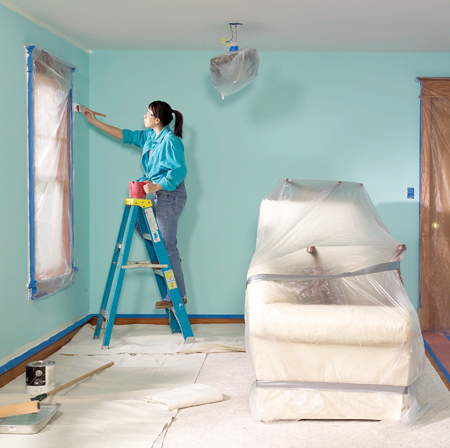
Stack up the furniture
Cramped working conditions lead to messy accidents. If you can’t move furniture completely out of the room, stack it up. Set upholstered chairs upside down on the sofa. Cover the dining room tabletop with cardboard so you can set chairs on top of it. But don’t let your stack become an obstacle. Maintain a generous workspace of at least 3 ft. between the stack and the walls. Cover your furniture stack with plastic.
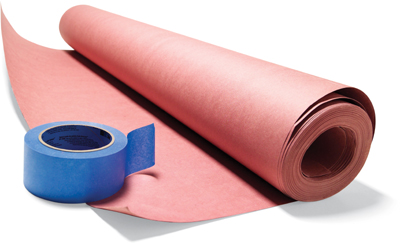
Protect hard floors with paper
Both canvas and plastic dropcloths are slippery when laid over wood, vinyl or tile. For protection that stays put, you can’t beat rosin paper (available at home centers). Just tape sheets of it together and then tape the perimeter to the floor. Be sure to clean wood floors before laying down the paper; grit trapped underneath can lead to scratches. A single layer will protect against paint drips, but wipe up any spills before they can soak through.
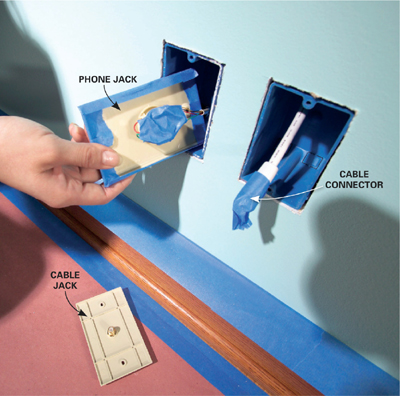
Mask off sensitive wiring
A little paint in the wrong place can cripple the connections that serve your phone, TV or computer. To protect phone jacks without disconnecting all those tiny wires, unscrew the faceplate and cover the front with masking tape. Then mask the terminals on the back of the plate. Slip the plate into the junction box. Disconnect coaxial cable from its plate and tape the cable’s connector.
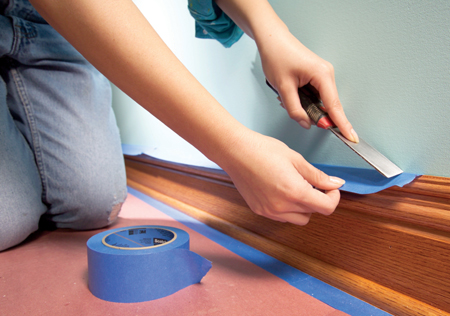
Shelter baseboard with tape
Don’t waste time by completely covering baseboard with several strips of tape. A single overhanging strip of wide tape will catch roller splatters just as the roof overhang on your house keeps rain off the siding. Use 1-1/2-in. tape for narrow baseboard, 2-in. tape for wider baseboard. Tape won’t stay stuck to dusty surfaces, so wipe down all your trim before masking. To minimize paint seepage under the tape, press the tape down hard by running a flexible putty knife over it.
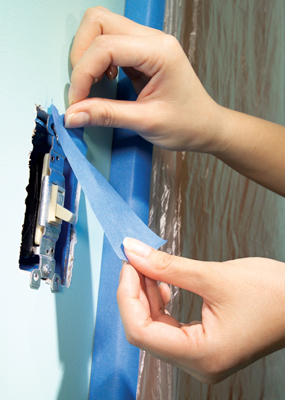
Tape over switches and outlets
Don’t try to paint around electrical cover plates. Removing them takes just a few seconds and makes for a faster, neater job. Unscrew cover plates and then shield each switch or outlet with 2-in.-wide masking tape. Also remove curtain hardware, picture hooks, grilles that cover duct openings and anything else that might get in your way. The thermostat is one exception—it’s easier to wrap it with masking tape than to remove and reinstall it.
Caution: Turn off the power before removing cover plates.
Voice of experience
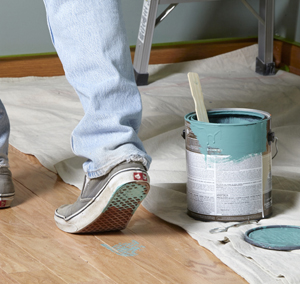
Don’t make tracks
Remember that when you’re walking on dropcloths, you’re walking on paint spills. Always check your shoes before walking away. My habit is to kick off my shoes before leaving the work area.
Jim Peterson, pro painter
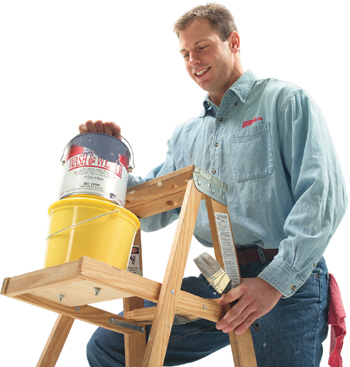
Spill-proof paint can
After an ugly accident, I bolted a large bucket to my ladder. That gives me a safe place to set my paint can.
Russel Durrwachter, The Family Handyman Field Editor
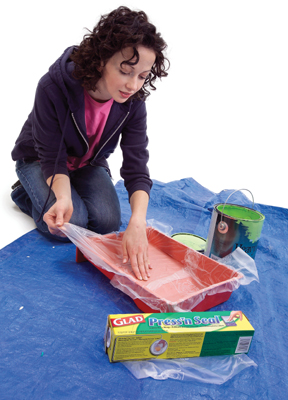
Not just for the kitchen
Painters love Glad Press’n Seal self-stick kitchen wrap because it goes on fast and stays put. Line paint trays to eliminate cleanup later or use it to shield any surface.
Lou Taylor, pro painter
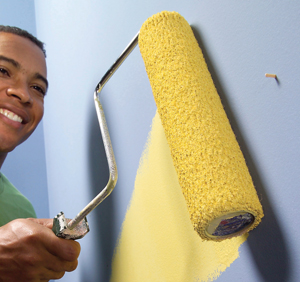
Preserve picture holes
A fresh coat of paint can fill and hide small nail holes. So if you plan to hang pictures in the same locations after painting, stick toothpicks or large-headed pins in the holes. If you leave them protruding just a little, you can roll right over them.
Jim Christensen, The Family Handyman Field Editor












